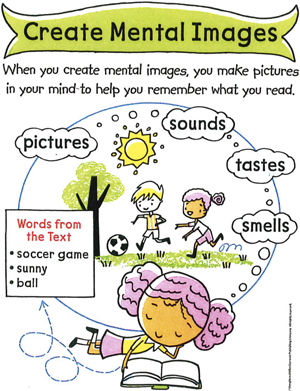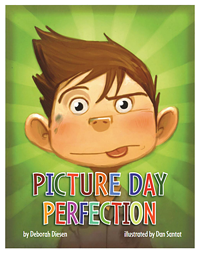Reading: Create Mental Images
Reading: Create Mental Images

When authors write a story, they know that every word is important. Many of the words in a story give information that helps readers picture in their minds what is happening. It is important to pay attention to details that help you create a picture in your mind, or a mental image.
Notice words the author uses to describe how a person, place, or thing looks, sounds, feels, smells, or tastes. Describing words give details that can help you make a picture in your mind. Creating a mental image helps you remember what you read. It is like creating a movie in your head as you read the text. It can also help readers stay focused and understand what is happening in the story.

Read Aloud: Student Instructions
To practice using details from the text to create mental images read Picture Day Perfection (in your online textbook, click Module 1, then click the Contents menu at the top left of your browser, and click the book title).
Before you begin, PREVIEW the text and PREDICT what the text will be about. You may write your prediction down (optional). As you read the story, you can then confirm or reject your prediction.
Read Aloud Steps
- Step 1: Read each question aloud. Pause after each of the page numbers to think about your answer.
- Step 2: Answer the questions aloud with someone. You do not need to write or turn in the answers for this section.
Parent/Guardian: Check the student's responses with the answer key
, Reading: Create Mental Images (1.3.2).
- p. 86:
- Who is telling the story?
- What clues help you know?
- Why do you think the author chose this person to tell the story?
- What does the main character want to do?
- p. 87:
- What is bedhead?
- How do you think the boy feels about having bedhead? What evidence tells you this?
The text on p. 88 says that the boy “unearthed” his favorite shirt. This means he had to dig through his hamper to find it. I can picture him searching, tossing clothes out of the hamper, and I can see all the dirty clothes piling up on the floor around him. The text also says that the shirt was at the “very bottom” of his hamper. I can see the boy with his head practically inside the hamper, tossing out more clothes until nothing is left but that shirt.
- p. 90: What do you think the boy’s shirt looks like now? Look for details that help you make a picture in your mind.
- p. 92: What unlucky thing happens to the boy on this page? Use details to retell what happens.
- p. 93:
- How do you think the boy is feeling at this point in the story?
- Why do you think he is feeling this way? Look for evidence in the text and illustration.
- p. 94:
- In your own words, explain why the boy gets in trouble. Use details in the text and illustrations to retell what happens.
- What does this tell you about what the boy is like?
- p. 95:
- Reread this page. What do you think happened after the boy got in trouble for making a face?
- What details help you picture what the boy’s shirt looks like now? Create a mental image to help you describe it.
- p. 97:
- What phrases in the text help you imagine what it feels like to sit on the stool?
- Why does the author compare a stool to a rock and an iceberg?
- p. 99: Why do you think the author ended the sentence this way?
On p. 100, I see the word CLICK! in big, dark letters. I can hear that sound in my head—it’s the sound of the camera taking a picture. I can also use the boy’s description of all his hard work to picture what he looks like as the camera goes off. His hair is messy, his face is dirty, and he has a scowling look on his face. His shirt is dirty and wrinkled. That does not sound like the perfect school picture to me!
- p. 101:
- What does the boy mean when he said that his hard work was ruined “in a moment of weakness”?
- What does the boy’s mom say about his picture?
- Does the boy agree? Explain your answer.
- p. 102:
- What do you think the boy plans to do for next year’s school picture?
- How do you know?
Texas Tech K-12
-
Address
Texas Tech Plaza | 1901 University Ave, Lubbock, TX 79401 -
Phone
(800) 692-6877 -
Email
ttuk12@ttu.edu

